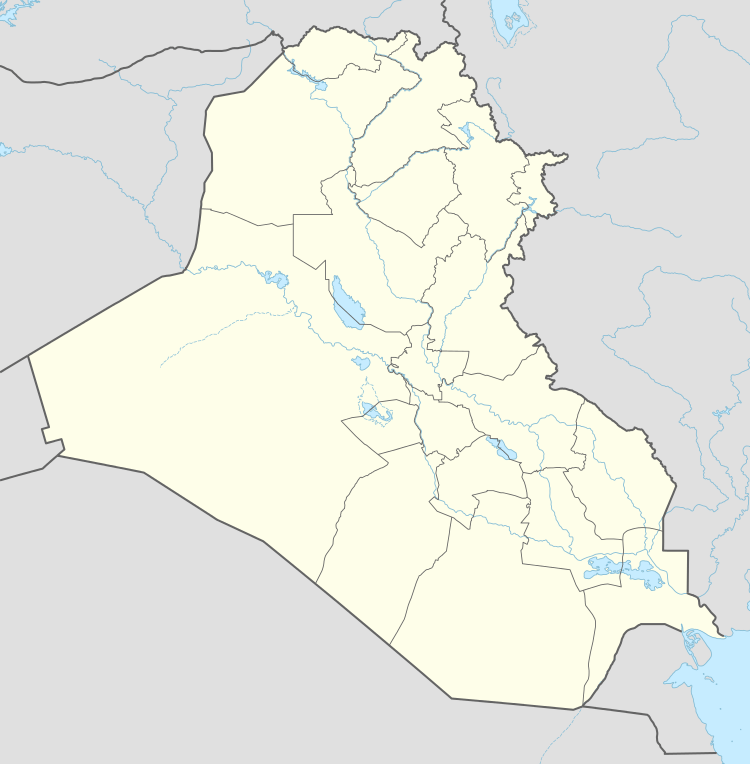Abu Salabikh
The low tells at Abu Salabikh, around 20 km (12 mi) northwest of the site of ancient Nippur in Al-Qādisiyyah Governorate, Iraq mark the site of a small Sumerian city state of the mid third millennium BCE,[1] with cultural connections to the cities of Kish, Mari and Ebla.[2] Its contemporary name is uncertain: perhaps this was Eresh.[3] Kesh was suggested by Thorkild Jacobsen before excavations began. The Euphrates was the city's highway and lifeline; when it shifted its old bed,[4] in the middle third millennium BCE, the city dwindled away. Only eroded traces remain on the site's surface of habitation after the Early Dynastic Period.[5] The site consists of several mounds, the 12 hectare wall enclosed Main (Early Dynastic), the 10 hectare Uruk, the West, and the 8 hectare South.
 Shown within Iraq | |
| Location | Al-Qādisiyyah Governorate, Iraq |
|---|---|
| Region | Mesopotamia |
| Coordinates | 32°16′00″N 45°05′00″E |
| Type | Settlement |
| History | |
| Founded | Middle of the third millennium BCE |
Archaeology
Abu Salabikh was excavated by an American expedition from the Oriental Institute of Chicago led by Donald P. Hansen in 1963 and 1965 for a total of 8 weeks, finding around 500 tablets and fragments, containing some of the earliest ancient literature.[6]
The site was a British concern after 1975, under the direction of Nicholas Postgate for the British School of Archaeology in Iraq (1975–89), after which excavations were suspended with the Iraqi invasion of Kuwait in 1990; "plans to resume fieldwork have now been abandoned in the light of current political conditions" Postgate reports.[7] The city, built on a rectilinear plan in Early Uruk times, revealed a small but important repertory of cuneiform texts on some 500 tablets, of which the originals were stored in the Iraq Museum, Baghdad, and were largely lost when the museum was looted in the early stages of the Second Iraq War; fortunately they had been carefully published. Texts, comparable in date and content with texts from Shuruppak (modern Fara, Iraq) included school texts, literary texts,[8] word lists, and some administrative archives, as well as the Instructions of Shuruppak, a well-known Sumerian "wisdom' text of which the Abu Salabikh tablet is the oldest copy. A list of deities includes the oldest known mention of the Semitic god Baʿal.[9] Postgate's interdisciplinary approach was integrated under the broad aim of describing the daily life of a small Sumerian city, down to the lives of the simplest illiterate inhabitants.[10]
See also
- Cities of the Ancient Near East
References
- Ian Shaw, in Shaw and Robert Jameson, eds., A Dictionary of Archaeology (Blackwell) 2002, s.v. "Abu Salabikh".
- P. R. S. Moorey, "Abu Salabikh, Kish, Mari and Ebla: Mid-Third Millennium Archaeological Interconnections", American Journal of Archaeology 85.4 (October 1981:447–448).
- Roger Matthews, The Archaeology of Mesopotamia: Theories and Approaches (Routledge) 2003:163; see also Mark E. Cohen's speculation in note below
- Identified to the west of the Main Mound by coring techniques.
- "Occupation ceased at the end of Early Dynastic Period IIIa, or shortly thereafter, and the site was never reoccupied:", concludes D. Hanson in Oriental Institute Papers 99, p. 55).
- R. D. Biggs, with a chapter by D. P. Hansen. Inscriptions from Tell Abu Salabikh, (Chicago: The University of Chicago Press), 1974 ISBN 0-226-62202-9. Transcribes all of the cuneiform tablets excavated at Tell Abu Salabikh in 1963 and 1965. (also available online OIP 99
- Prof. Nicholas Postgate : Postgate turned his attention to the multiperiod site at Kilise Tepe, in the province of Mersin in southern Turkey.
- "We are now able to behold the earliest creative period of Sumerian belles lettres", remarked Mark E. Cohen in 1976 (Cohen, "The Name Nintinugga with a Note on the Possible Identification of Tell Abu Salābīkh" Journal of Cuneiform Studies, 28.2 [April 1976:82–92]). Cohen identifies the contemporaneous name of the city, from the "zà-mì hymns", as Gišgikidu, "Gišgi, the good place".
- Herrmann (1999), p. 132.
- Postgate summarized the discoveries at Abu Salabikh in the relevant article in J. Curtis, ed., Fifty Years of Mesopotamian Discovery(London) 1982:48–61.
Bibliography
- Herrmann, Wolfgang (1999), "Baal", Dictionary of Deities and Demons in the Bible, 2nd ed., Grand Rapids: Wm. B. Eerdmans Publishing, pp. 132–139.
Further reading
- Matthews, R. and Matthews, W. (2017) A palace for the king ofEres? Evidence from the Early Dynastic City of Abu Salabikh, south Iraq. In: Heffron, Y., Stone, A. and Worthington, M. (eds.) At the dawn of history. Ancient Near Eastern studies in honour of J. N. Postgate. Eisenbrauns, Winona Lake, pp. 359-367. ISBN 9781575064710
- Robert D. Biggs, The Abu Salabikh Tablets. A Preliminary Survey, Journal of Cuneiform Studies, vol. 20, no. 2, pp. 73–88, 1966
- Postgate, J. N., and Moorey, P. R. S., 1976. Excavations at Abu Salabikh, Iraq, vol. 38, pp. 133–69, 1975
- Nicholas Postgate, "Excavations at Abu Salabikh 1976", Iraq, vol. 39, pp. 269–299, 1977
- Nicholas Postgate, "Excavations at Abu Salabikh 1977', Iraq, vol. 40, pp. 89-100, 1978
- Nicholas Postgate, "Excavations at Abu Salabikh 1978-79", Iraq, vol. 42, no. 2, pp. 87–104, 1980
- Nicholas Postgate and J.A. Moon, "Excavations at Abu Salabikh 1981", Iraq, vol. 44, no. 2, pp. 103–136, 1982
- Nicholas Postgate, "Excavations at Abu Salabikh 1983", Iraq, vol. 46, pp. 95–114, 1984
- R.J. Matthews and Nicholas Postgate, "Excavations at Abu Salabikh 1985-86", Iraq, vol. 49, pp. 91–120, 1987
- Nicholas Postgate, "Excavations at Abu Salabikh 1988-89", Iraq, vol. 52, pp. 95–106, 1990
- Susan Pollock, Caroline Steele and Melody Pope, Investigations on the Uruk Mound, Abu Salabikh, 1990, Iraq, vol. 53, pp. 59-68, 1991
- Nicholas Postgate, “Early Dynastic burial customs at Abu Salabikh”, in Sumer 36, pp. 65–82, 1980
- Postgate J.N. and Moon J.A., Excavations at Abu Salabikh, a Sumerian city, National Geographic Research Reports: 1976 projects, vol. 17, pp. 721-743, 1984